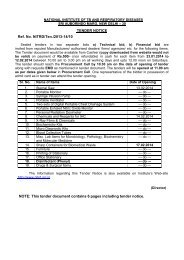The Indian Journal of Tuberculosis - LRS Institute of Tuberculosis ...
The Indian Journal of Tuberculosis - LRS Institute of Tuberculosis ...
The Indian Journal of Tuberculosis - LRS Institute of Tuberculosis ...
Create successful ePaper yourself
Turn your PDF publications into a flip-book with our unique Google optimized e-Paper software.
SUMMARIES OF PAPERS 165<br />
Conclusion: <strong>The</strong> pleural fluid cholinesterase and its<br />
ratio with serum cholinesterase are one <strong>of</strong> the most<br />
accurate criteria in characterizing pleural effusions<br />
as exudates or transudates. <strong>The</strong> same can be used<br />
as the first step in diagnosis <strong>of</strong> pleural effusion. It is<br />
also cost-effective in resource poor settings.<br />
Pyrazinamide susceptibility testing <strong>of</strong> M.<br />
tuberculosis by BacT/ALERT 3D system, L.J<br />
Proportion Method and Pyrazinamidase assay<br />
Pushpendra Singh, Abhay Kumar Mishra, Clement<br />
Wesley, Kalpana, Sunil Malonia, G.P.S. Jadaun,<br />
Jaya Faujdar, P. Upadhyay, P. Gupta, R. Das,<br />
O.S. Chauhan. Y.D. Sharma, U.D. Gupta,<br />
K Venkatesa and V.M. Katoch<br />
Background: Pyrazinamide (PZA) has been used in<br />
the therapy <strong>of</strong> tuberculosis for long time. A<br />
nicotinamide analogue pro-drug with sterilizing<br />
activity against semi-dormant tubercle bacilli, PZA<br />
requires bacterial Pyrazinamidase (PZase) enzyme<br />
activity for being converted into bactericidal moiety<br />
pyrazinoic acid (POA). MIC <strong>of</strong> PZA is pH dependant<br />
which makes PZA susceptibility testing difficult. Over<br />
the years, several liquid medium based rapid systems<br />
including radiometric BACTEC 460, fluorimetric<br />
MGIT 960 and colorimetric BacT/Alert system have<br />
been tested and found to be promising for PZA<br />
susceptibility testing. <strong>The</strong>re has been no comparative<br />
evaluation <strong>of</strong> PZA susceptibility testing by BacT/<br />
ALERT 3D system, L-J Proportion Method and<br />
Pyrazinamidase assay.<br />
Objectives <strong>of</strong> the study: Present study has been<br />
carried out to compare the results <strong>of</strong> PZA<br />
susceptibility testing by BacT/Alert system, L-J<br />
Proportion Method and Pyrazinamidase assay.<br />
Methodology <strong>of</strong> investigation: A total <strong>of</strong> 107 isolates<br />
<strong>of</strong> M. tuberculosis were tested by L-J Proportion<br />
(Gold Standard), BacT/Alert and PZase assay as per<br />
the standard method described for these tests.<br />
Main findings: A good concordance (90.65%) was<br />
observed among the results <strong>of</strong> these methods.<br />
Sensitivity <strong>of</strong> BacT/Alert system in present study<br />
(34/36=94.5%) was significantly better (P value<br />
lesser than 0.05) than that <strong>of</strong> the PZase assay (29/<br />
36=80.56%) whereas no significant difference in their<br />
specificities was observed (P value more than 0.05).<br />
BacT/Alert system is a rapid and accurate method<br />
for PZA susceptibility testing with high sensitivity<br />
and specificity.<br />
MDR –TB : Treatment Outcome<br />
S. Raiasekaran, P.R. Khaiser Ahamed, A.<br />
Mahilmaran, O.R. Krishnarajasekhar, S. Kumar,<br />
Dravidaselvanayagi and Mala<br />
Background: Government Hospital <strong>of</strong> Thoracic<br />
Medicine (GHTM), Tambaram, is the largest centre<br />
in India managing MDR- <strong>Tuberculosis</strong>. On any given<br />
day, there would be at least 140 in-patients receiving<br />
retreatment for MDR- TB.<br />
Objective: To share the experience <strong>of</strong> GHTM in<br />
managing MDR-TB and to present the details <strong>of</strong><br />
treatment outcome.<br />
Methodology: Patients, who were confirmed to have<br />
MDR-TB admitted during 2002 to 2005, were<br />
considered for the analysis. <strong>The</strong> evaluation would<br />
cover pattern <strong>of</strong> drug resistance, drug regimens and<br />
treatment outcome.<br />
Results and Conclusions: 400 patients were taken<br />
up for the analysis. <strong>The</strong> results were being compiled<br />
(at the time <strong>of</strong> abstract) and would be projected in<br />
greater detail.<br />
Prediction vs optimal diagnostic tool for MDR<br />
TB in developing countries<br />
C. Venkatesh, R. Atharunnisa Begum and B.<br />
Rajagopalan<br />
Objective: To assess the value <strong>of</strong> prediction <strong>of</strong> drug<br />
resistance among CAT II failure cases<br />
Methodology: All the Cat II failure cases attending<br />
the <strong>Institute</strong> <strong>of</strong> Thoracic Medicine, Chennai, were<br />
interrogated for detailed previous anti-tuberculous<br />
treatment history and subjected to thorough clinicalexamination.<br />
Based upon the prior treatment history,<br />
<strong>Indian</strong> <strong>Journal</strong> <strong>of</strong> <strong>Tuberculosis</strong>
















